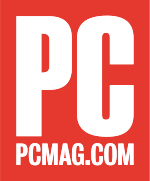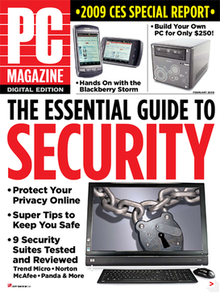PCMag
 | |
 The digital edition of PC Magazine, as of September 2011 | |
| Editor | Wendy Sheehan Donnell |
|---|---|
| Former editors | Dan Costa, Lance Ulanoff, Jim Louderback, Michael J. Miller, Bill Machrone, David Bunnell |
| Categories | Computer magazine |
| First issue | February/March 1982 (as PC) |
| Final issue | January 2009 (print) |
| Country | United States |
| Based in | New York |
| Language | English |
| Website | www |
| ISSN | 0888-8507 |
| OCLC | 960872918 |
PC Magazine (shortened as PCMag) is an American computer magazine published by Ziff Davis. A print edition was published from 1982 to January 2009. Publication of online editions started in late 1994 and continues as of 2024[update].
Overview
[edit]PC Magazine provides reviews and previews of the latest hardware and software for the information technology professional. Other regular departments include columns by long-time editor-in-chief Michael J. Miller ("Forward Thinking"), Bill Machrone, and Jim Louderback, as well as:
- "First Looks" (a collection of reviews of newly released products)
- "Pipeline" (a collection of short articles and snippets on computer-industry developments)
- "Solutions" (which includes various how-to articles)
- "User-to-User" (a section in which the magazine's experts answer user-submitted questions)
- "After Hours" (a section about various computer entertainment products; the designation "After Hours" is a legacy of the magazine's traditional orientation towards business computing.)
- "Abort, Retry, Fail?" (a beginning-of-the-magazine humor page which for a few years was known as "Backspace"—and was subsequently the last page).
For several years in the 1980s, PC Magazine gave significant coverage to programming for the IBM PC and compatibles in languages such as Turbo Pascal, BASIC, Assembly and C. Charles Petzold was one of the notable writers on programming topics.
Editor Bill Machrone wrote in 1985, that If an article doesn't evaluate products or enhance productivity, "chances are it doesn't belong in PC Magazine".[1][2]
History
[edit]In an early review of the new IBM PC, Byte reported that PC: The Independent Guide to the IBM Personal Computer "should be of great interest to owners".[3] The first issue of PC, dated February–March 1982,[4] appeared early that year.[5] (The word Magazine was added to the name with the third issue in June 1982,[6] but not added to the logo until January 1986.)[2]
PC Magazine was created by David Bunnell, Jim Edlin, and Cheryl Woodard[7] (who also helped Bunnell found the subsequent PC World and Macworld magazines). David Bunnell, Edward Currie and Tony Gold were the magazines co-founders. Bunnell and Currie created the magazine's business plan at Lifeboat Associates in New York which included, in addition to PC Magazine, explicit plans for publication of PC Tech, PC Week and PC Expositions (PC Expo) all of which were subsequently realized. Tony Gold, a co-founder of Lifeboat Associates financed the magazine in the early stages. The magazine grew beyond the capital required to publish it; to solve this problem, Gold sold the magazine to Ziff-Davis, moving from California to New York City.[8] By February 1983 it was published by PC Communications Corp., a subsidiary of Ziff-Davis Publishing Co., Bunnell and his staff left to form PC World magazine.[9] The first issue of PC carried an interview with Bill Gates,[10] made possible by his friendship with David Bunnell, who was among the first journalists and writers to take an interest in personal computing.[11]
Early transition to square binding
[edit]By its third issue PC was square-bound because it was too thick for saddle-stitch. At first the magazine published new issues every two months, but became monthly as of the August 1982 issue, its fourth.[6] In March 1983 a reader urged the magazine to consider switching to a biweekly schedule because of its thickness.[12] Although the magazine replied to the reader's proposal with "Please say you're kidding about the bi-weekly schedule. Please?",[12] after the December 1983 issue reached 800 pages in size,[13] in 1984 PC began publishing new issues every two weeks, with each about 400 pages in size.[5] In January 2008 the magazine dropped back to monthly issues.[14] Print circulation peaked at 1.2 million in the late 1990s. In November 2008 it was announced that the print edition would be discontinued as of the January 2009 issue, but the online version at pcmag.com would continue. By this time print circulation had declined to about 600,000.[15][16] In the December 2022 issue, it was announced that the issue was the last one following the magazine format, and focus was shifted to the pcmag.com website.
The magazine had no ISSN until 1983, when it was assigned ISSN 0745-2500, which was later changed to ISSN 0888-8507.
PC Magazine uses Google Books as the official archive of its 27 years as a print publication.[2]
Editor
[edit]Wendy Sheehan Donnell was appointed editor-in-chief of PCMag.com in January 2022.[17] Donnell had been deputy editor under the previous editor-in-chief, Dan Costa.[18] Costa was editor-in-chief from August 2011 to December 2021. Lance Ulanoff held the position of editor-in-chief from July 2007 to July 2011.[19]
Jim Louderback was editor-in-chief before Ulanoff, from 2005, and left to become chief executive officer of online media company Revision3.
Development and evolution
[edit]This article needs to be updated. (November 2010) |
The magazine evolved significantly over the years. The most drastic change was the shrinkage of the publication due to contractions in the computer-industry ad market and the easy availability of the Internet, which made computer magazines less necessary. This is also the primary reason for the November 2008 decision to discontinue the print version.[20] It has adapted to the new realities of the 21st century by reducing its once-standard emphasis on massive comparative reviews of computer systems, hardware peripherals, and software packages to focus more on the broader consumer-electronics market. From the late 1990s, the magazine more frequently reviewed Macintosh software and hardware.
PC Magazine was one of the first publications to have a formal test facility, which they called PC Labs. The name was used early in the magazine, and a physical PC Labs was built at the magazine's 1 Park Avenue, New York facility in 1986. William Wong was the first PC Labs Director.[21] PC Labs created a series of benchmarks, of which older versions can be found on the internet.[22] PC Labs was designed to help writers and editors to evaluate PC hardware and software, especially for large projects like the annual printer edition where almost a hundred printers were compared using PC Labs printer benchmarks.[23]
See also
[edit]- DOS Power Tools, sponsored by PC Magazine
References
[edit]- ^ Machrone, Bill (1985-11-26). "Compatibility Wars—Here and Abroad". PC Magazine. p. 59.
- ^ a b c griffith, eric (2022-09-27). "40 Years of PCMag: An Illustrated Guide". PC Magazine. Archived from the original on 2023-01-29.
- ^ Williams, Gregg (January 1982). "A Closer Look at the IBM Personal Computer". BYTE. p. 36.
- ^ "Front cover". PC Magazine. Feb–Mar 1982. p. 1.
- ^ a b Sandler, Corey (November 1984). "IBM: Colossus of Armonk". Creative Computing. p. 298. Archived from the original on 2013-09-28.
- ^ a b Bunnell, David (June–July 1982). "For Ten Minutes PC Was Free". PC Magazine. Vol. 1, no. 3. p. 19. Archived from the original on 2023-12-19. Retrieved 2020-11-18.
- ^ "Publishing Business Group: How We Started PC Magazine". www.publishingbiz.com. Archived from the original on 2016-07-30.
- ^ "40 Years of PCMag: An Illustrated Guide". PCMAG. Archived from the original on 2023-01-29.
- ^ Wise, Deborah (1982-12-20). "Staff Walks Out on PC Magazine, Starts New Journal". InfoWorld. 4 (50). Popular Computing, Inc.: 1–8. ISSN 0199-6649. Archived from the original on 2024-07-14. Retrieved 2015-12-22.
- ^ Bunnell, David (Feb–Mar 1982). "The Man Behind The Machine?". PC Magazine (interview). p. 16. Archived from the original on 2024-02-07. Retrieved 2020-11-18.
- ^ Lohr, Steve (1995-06-19). "Adapting 60's Sensibilities to the Internet". The New York Times. ISSN 0362-4331. Archived from the original on 2018-11-30.
- ^ a b Siebert, Bill (March 1983). "Double Time". PC Magazine. p. 31. Archived from the original on 2023-12-19. Retrieved 2020-11-18.
- ^ "Front cover". PC. December 1983. Archived from the original on 2023-12-19. Retrieved 2020-11-18.
- ^ "PC Magazine issues list". PC Magazine. Archived from the original on 2012-03-28.
- ^ Lance Ulanoff (2008-11-19). "PC Magazine Goes 100% Digital". PC Magazine. Archived from the original on 2011-01-08.
- ^ Clifford, Stephanie (2008-11-19). "PC Magazine, a Flagship for Ziff Davis, Will Cease Printing a Paper Version". The New York Times. Archived from the original on 2017-07-13.
- ^ Silber, Tony (2022-01-25). "Ziff Media Group Appoints New PCMag and Mashable Editors-in-chief". MediaPost.com. Archived from the original on 2022-01-27.
- ^ "New editor at PCMag.com". talkingbiznews.com. 2011-07-12. Archived from the original on 2022-01-27.
- ^ "Ulanoff Named Editor in Chief of PC Magazine Network". adage.com. 2008-04-11. Archived from the original on 2022-01-27.
- ^ "PC Magazine Goes 100% Digital". PCMAG. Archived from the original on 2023-03-14. Retrieved 2023-12-19.
- ^ Wong, William (2018). "Remembering PC Mag Editors". electronicdesign.com. Archived from the original on 2021-08-05. Retrieved 2021-03-26.
- ^ "PC Magazine Labs Performance Tests 1.x". winworldpc.com. Archived from the original on 2021-07-28. Retrieved 2021-03-26.
- ^ "PC Magazine". PCMag. 5 (19). 1986. Archived from the original on 2023-12-19. Retrieved 2021-03-26.
External links
[edit]- Monthly magazines published in the United States
- Video game magazines published in the United States
- Arabic-language magazines
- Magazines published in Belgium
- Biweekly magazines published in the United States
- Magazines published in Brazil
- Magazines published in Bulgaria
- Chinese-language magazines
- Online computer magazines
- Defunct computer magazines published in the United States
- Computer magazines published in the Netherlands
- Video game magazines published in the Netherlands
- English-language magazines
- Magazines published in Greece
- Greek-language magazines
- Home computer magazines
- Magazines published in Israel
- Magazines established in 1982
- Magazines disestablished in 2009
- Magazines published in New York (state)
- Magazines published in Mexico
- Online magazines with defunct print editions
- Portuguese-language magazines
- Magazines published in Romania
- Monthly magazines published in Russia
- Computer magazines published in Russia
- Video game magazines published in Russia
- Computer magazines published in Serbia
- Serbian-language magazines
- Magazines published in Singapore
- Spanish-language magazines
- Computer magazines published in Spain
- Video game magazines published in Spain
